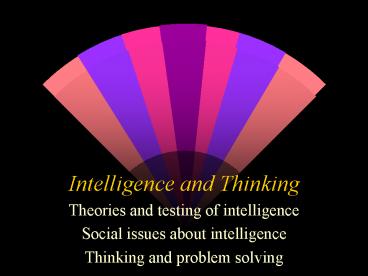Intelligence and Thinking - PowerPoint PPT Presentation
1 / 29
Title:
Intelligence and Thinking
Description:
The SAT and ACT as intelligence tests. Potential problems with IQ tests. Culture bias ... Mass media and stereotypes: I love Lucy? Imagery, persuasion, and sales ... – PowerPoint PPT presentation
Number of Views:103
Avg rating:3.0/5.0
Title: Intelligence and Thinking
1
Intelligence and Thinking
- Theories and testing of intelligence
- Social issues about intelligence
- Thinking and problem solving
2
Intelligence
- The capacity to learn and remember, and to adapt
to the demands of the physical and cultural
environment. - Three approaches to the study of intelligence
- Differential approach (Galton and Binet)
- Developmental approach (Piaget)
- Information processing approach
3
Theories of intelligence
- Pearsons G theory All abilities correlate
- Spearmans 2-factor theory
- g Correlations among abilities
- Apprehension of experience
- Eduction of relations
- Eduction of correlates
- s The part of a tested ability that does not
correlate with other abilities
4
Analogies
- manwomanboy_______
- carthorse_____truck
- carthorserun_____
- kingqueenprince_______
- kingqueenmarquis_______
5
Factor analysis results
- Labelling factors is an art
- Three factors Birren and Morrison, 1961
- General or verbal ability
- Working memory words and numbers
- Spatial ability
6
Thurstones 7 factors (1938)
- Verbal comprehension
- Verbal fluency
- Number
- Spatial visualization
- Memory
- Reasoning
- Perceptual speed
7
Cattells second-order analysis (1966)
- Fluid intelligence Innate
- Crystallized intelligence Acquired
8
Sternbergs Triarchic theory
- Componential intelligence Mental mechanisms
- Metacomponents
- Performance components
- Knowledge acquisition components
- Experiential intelligence (crystallized)
- Contextual intelligence
- Adaptation, selection, and shaping
9
Gardners neuropsychological theory
- Seven intelligences Democratic appeal
- Remember Thurstone?
- Gardner keeps adding to his list
- Traditional Linguistic, spatial, musical, and
logical mathematical - Novel Bodily-kinesthetic, intrapersonal,
interpersonal - All intercorrelate
10
Intelligence testing
- Binet-Simon scale MA
- Stanford-Binet scale IQ MA/CA
- Wechsler and the deviation IQ
- Verbal and performance IQ
- Reliability and validity
- The SAT and ACT as intelligence tests
11
Potential problems with IQ tests
- Culture bias
- Gender bias
- Learning disabilities
12
Mental retardation
- Mild 52-67
- Moderate 36-51
- Severe 20-35
- Profound
13
(No Transcript)
14
Thinking and language
- Sensation...Perception...
- Learning...Memory...
- Thought...Language
15
- Which of these are fruit?
- apple
- pear
- banana
- cherry
- tomato
- strawberry
16
Components of cognition
- Concept formation
- Groups
- Prototypes
- Stereotypes
- Problem solving
- Trial and error
- Algorithms
- Heuristics
- Insight
- Mental models
17
Mental models
- Although the four craftsmen were brothers, they
varied enormously in height. The electrician was
the very tallest, and the plumber was shorter
than him. The plumber was taller than the
carpenter, who, in turn, was taller than the
painter. - Was the plumber taller than the carpenter?
- Was the plumber taller than the electrician?
- Was the electrician taller than the painter?
18
Obstacles to problem solving
- Confirmation bias
- In logical analysis Wason (1960) 2 - 4 - 6
- In social relations
- Fixation
- Mental set
- Luchins water jars
- Functional fixedness
- Candle mounting
19
Help and harm by heuristics
- The representativeness heuristic
- The conjunction fallacy
- Bill plays jazz for a hobby
- Bill is an accountant who plays jazz for a hobby
- Critical thinking The probability of two events
occurring together (conjunction) cannot exceed
the probability of either event alone.
20
Misleading heuristics
- The availability heuristic
- Information that is more readily recalled is
judged to be more likely k first or third? - Vivid memories of accidents and safety
- Mass media and stereotypes I love Lucy?
- Imagery, persuasion, and sales
21
- Who is more likely to believe in UFOs...a
40-year-old member of a cult or a recent college
graduate?
22
Heuristics and rationality
- Overconfidence Remember how long the Mississippi
River is? - Overconfidence and error vs. willingness to
decide - Who predicts performance more accurately
depressed people or non-depressed people?
23
Framing effects
- Remember the effect of survey wording from
chapter 1? - 95 fat free! vs. Contains 5 fat.
- You earned a B when your friends got a C vs You
earned a B when your friends got an A.
24
Beliefs bias our use of reason Form and content
concordant
- People who love live in God.
- Christians love.
- Therefore, Christians live in God.
25
Belief bias Form and content discordant
- People who love live in God.
- Hateful people do not love.
- Therefore, hateful people do not live in God.
26
Belief bias observed Form and content concordant
- People who love eat food.
- Hateful people do not love.
- Therefore, hateful people do not eat food.
27
Belief perseverance
- Developed beliefs persist in the face of
contradictory evidence. - Explanations we develop to explain our
experiences become fixed beliefs, even when they
are shown to be based on wrong evidence - Damaging influence of early failure
28
What can we do?
- Consider the opposite Cromwell
- Delay your attribution
- Remember the research
- Muddle along most of the time, but think
carefully about your influence on others.
29
The Luchins water jar problem
- Given a 21-cup jar, a 127-cup jar, and a 3-cup
jar, measure out exactly 100 cups - Given a 14-cup jar, a 46-cup jar, and a 5-cup
jar, measure out exactly 22 cups - Given an 18-cup jar, a 43-cup jar, and a 10-cup
jar, measure out exactly 5 cups - Given a 15-cup jar, a 39-cup jar, and a 3-cup
jar, measure out exactly 18 cups































